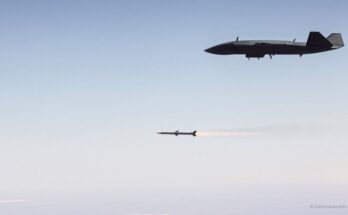
The Senate Appropriations Committee released its version of the FY22 defense spending bill earlier this week. The committee recommends adding billions of dollars to the FY22 defense spending bill, mirroring proposals from the House and Senate Armed Services Committees. House appropriators left the topline unchanged in their markup earlier this year, but that bill was drafted before the armed services committees expressed support for a larger defense budget in FY22.
Specifically, the Senate appropriations bill provides $725.8 billion for national defense, an increase of around $19.4 billion compared to the request. It should be noted that these figures exclude military construction, family housing, nuclear weapons programs, and civil defense, which are funded in separate appropriations bills. A total of $13.2 billion in extra funding would be added for procurement and research, development, test, and evaluation (RDT&E).
Following the collapse of the Afghan government, the committee rescinded $3.3 billion requested for the Afghan Security Forces Fund, as well as $500 million in prior-year funds. This money comes out of the Pentagon’s operations and maintenance account.
A summary of the bill outlines a number of other funding reductions made to free up money for capabilities in the Indo-Pacific region to counter China’s military growth and to allow for greater investment in artificial intelligence (AI), cyber, microelectronics, space, and infrastructure and public shipyards.
The bill cuts $433 million for the Space Force’s overhead persistent infrared satellites, noting that the requested funding amount exceeds the fixed-price contracted value. The legislation also splits OPIR funding into three separate budget lines covering GEO, Polar, and the ground command and control segment. These components were funded under a single funding line in the request. The committee also recommends rescinding $436 million in unobligated prior-year funding for the Joint Direct Attack Munition (JDAM) due to production delays.
The bill summary outlines a number of additions aimed at improving capabilities in the Pacific. The bill adds $793 million for Marine Corps unfunded priorities related to Force Design 2030, the service’s new organization construct that envisions a more mobile and distributed amphibious force capable of rapidly moving among islands in the Pacific. The committee adds $750 million to accelerate a missile tracking demonstration. This demo would address an Indo-Pacific Command (INDOPACOM) requirement for additional wide and medium field of view satellites that are currently not included in the Space Development Agency’s Tranche 0 or Tranche 1 tracking layer satellite plans. The legislation also adds $100 million for a Guam defense system and $41 million for the Homeland Defense Radar-Hawaii. The Pentagon wants to end the Hawaii radar program to focus money elsewhere, but multiple defense committees have made it clear they want the DoD to move ahead with the radar.

To address AI and cyber shortfalls, the bill adds $500 million for a program to increase the adoption of AI technology within combatant commands. Another $100 million is provided to help recruit AI developers. The bill adds $200 million for the trusted and assured microelectronics program, an effort that has become even more critical with recent supply chain shortages. The committee also wants to add $120 million for Space Force unfunded priorities.
All told, Senate appropriators want to add around $9 billion for DoD procurement programs. For comparison, the House Appropriations Committee’s markup from earlier in the year only added $1.7 billion for procurement.
The Senate legislation provides an extra $3 billion for warships, including one destroyer, one expeditionary sea base, two expeditionary fast transports, and two ship-to-shore connectors. However, funding is removed for five secondhand auxiliary sealift vessels. Another $1.2 billion is added for Navy aircraft, including nine V-22s (five MV-22 and four CMV-22), two KC-130Js, and three unmanned MQ-4C Tritons. Additional funding is also provided for eight G/ATOR radars for the Marine Corps.
Air Force aircraft funding is bolstered by $1.6 billion, which supports the procurement of an additional 16 C-130Js as well as eight MC-139A helicopters that were removed from the FY22 budget request. The bill also adds $1.1 billion to the Air Force’s Other Procurement account.
The Army would lose $174 million in procurement funding under the committee’s plan. The markup cuts $828 million for the Integrated Visual Augmentation System, an augmented reality goggle from Microsoft. The service is investing heavily in the technology over the coming years, but the program has faced recent delays. However, the bill would add funding for 23 Paladin howitzers and 20 upgraded Abrams tanks, as well as $60 million for HMMWVs, $120 million for Joint Light Tactical Vehicles, and $109 million for heavy tactical trucks.

The Senate also wants to add 14 Terminal High Altitude Area Defense (THAAD) system interceptors and eight SM-3 Block IIA interceptors. Another $1 billion is added for Israel’s Iron Dome missile defense system, but this funding is provided outside of the acquisition accounts. The bill also includes $1.5 billion for National Guard and Reserve equipment.
Senate appropriators recommend adding $4.2 billion for RDT&E, compared to a $1.6 billion reduction in the House version of the defense spending bill. The House and Senate Armed Services Committees recommended adding $6.1 billion and $4.1 billion, respectively.
Within the Senate appropriations markup, most of the additional research funding, some $3.3 billion, is for Defense-Wide agencies. Notable changes include an additional $855.7 million for test and evaluation efforts, $768 million for the aforementioned INDOPACOM missile tracking demo, and $61.9 million for hypersonic defense development.
The Air Force would gain $914.3 million for RDT&E. The bill adds $540 million for advanced engine development, comprising $460 million for the Adaptive Engine Transition Program (AETP) and $80 million for “vendor enhancements.” However, the bill cuts $172 million for F-35A modernization. It also adds $367.2 million for Space Force RDT&E. The Army would gain $668.3 million for its research projects, the bulk of which is for basic and applied research efforts. Those are the research categories that support initial concepts and early development work.
The Navy stands to lose $1.1 billion from its research account. That figure is partially deceiving because it includes a $955.2 million transfer for the Navy Next Generation Enterprise Network software pilot program to areas of the budget outside of the RDT&E account. However, the bill also cuts $174 million for F-35B/C modernization, $150.6 million for the E-6B replacement program (referred to as TACAMO modernization in the budget), $101.5 million for the Next Generation Jammer due to delays, and $106.1 million for conventional prompt strike.
A number of Republicans chastised the committee’s proposal as inadequate, despite the fact that it roughly falls in line with increases from other defense committees that had bipartisan support. The bill would result in an increase of around 5 percent for the Pentagon over FY21 levels. Republicans have long called for 3-5 percent real growth for defense. The Senate bill would fall on the low end of that scale, or below 3 percent real growth, depending on the final inflation rate for the year. Republicans also attacked a proposed 13 percent increase in non-defense spending for the year.
Lawmakers have until December 3 to negotiate a final appropriations bill for FY22. That is the expiration date for a continuing resolution that is keeping the government operating at FY21 levels due to the lack of a final FY22 budget. When looking at the recent committee markups, it seems likely the FY22 topline will end up in the neighborhood of $25 billion above the requested amount.
Forecast International’s U.S. Defense Budget Forecast is a streamlined database providing fast and easy access to the Pentagon’s entire acquisition budget. The product features new sorting and data visualization options, and presents the entire FYDP through an online interface with downloadable Excel spreadsheets. This is the go-to service for anyone familiar with the grind of wading through the massive DoD budget. Pricing begins at $2,295, with discounted full-library subscriptions available. Click here to learn more.
Shaun's deep-rooted interest in military equipment continues in his role as a senior defense analyst with a focus on the United States. He played an integral role in the development of Forecast International's U.S. Defense Budget Forecast, an interactive online product that tracks Pentagon acquisition programs throughout the congressional budget process. As editor of International Military Markets – North America, Shaun has cultivated a deep understanding of the vast defense markets in the United States and Canada. He is a regular contributor to Forecast International's Defense & Security Monitor blog and has co-authored white papers on global defense spending and various military programs.



